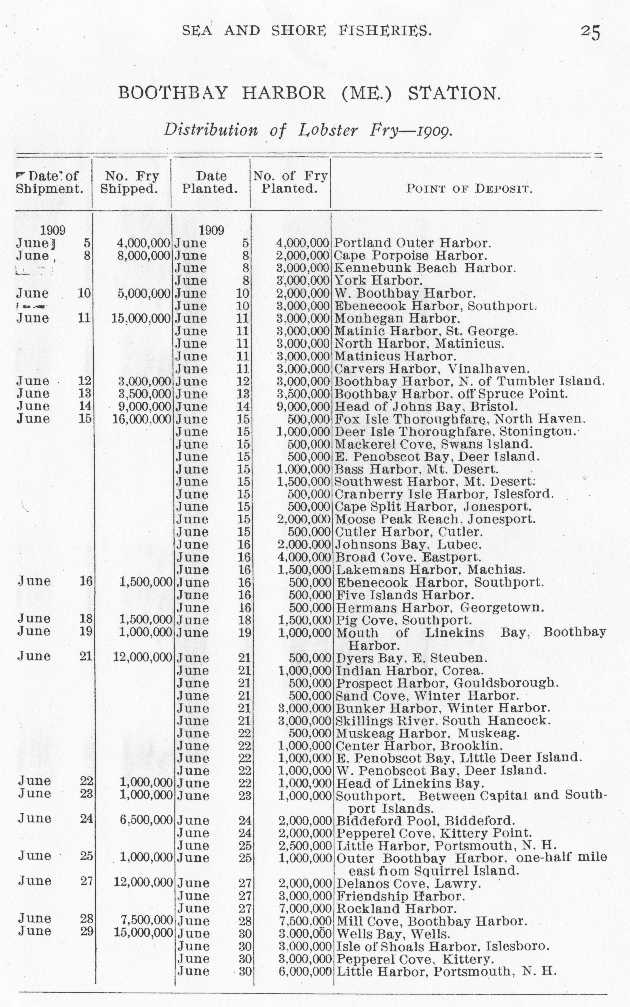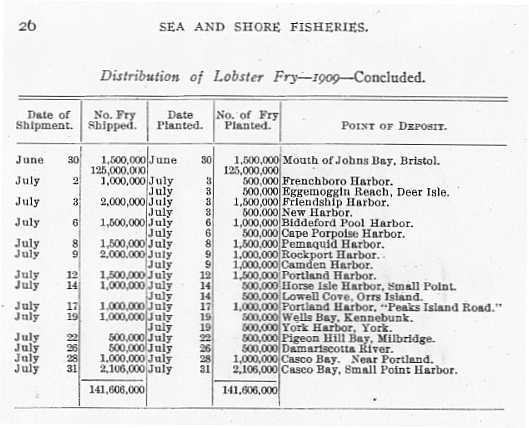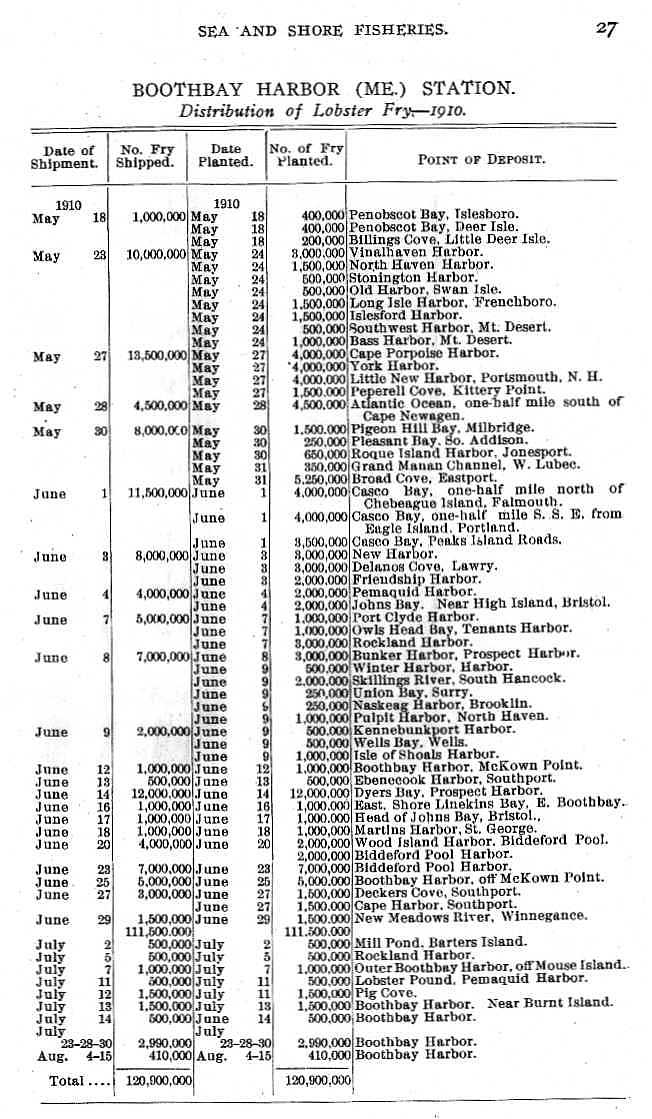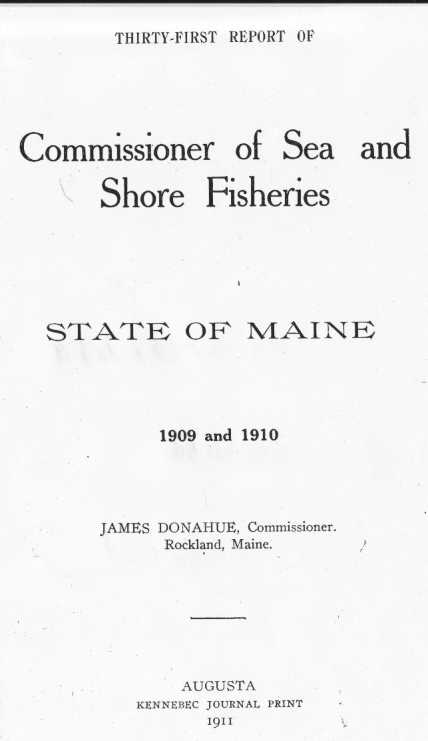 back
back
Thirty-First Report of
1909 and 1910.
James Donahue, Commissioner.
Augusta
1911
--------------------------------------------------------------------------------
CONTENTS.
SPECIES
Alewives 10
----------------------------------------------------------------------------------------------
Department of Sea and Shore Fisheries
December 23, 1908.
To His Excellency, Bert M. Fernald, Governor of Maine:
I herewith submit, as required by law, the thirty-first report of
Respectfully,
James Donahue, Commissioner.
--------------------------------------------------------------------------------
Maine Sea and Shore Fisheries 1909-10 Page 7
PRESENT AND COMPARATIVE VALUE TO THE
STATE OF MAINE OF THE SEA AND SHORE
FISHERIES.
1888 $2,292,000
Memo. The above is the value of the catch, and does not include the value of sardine canning factories or their products, nor that of wharves, buildings, boats, gear, traps, etc. A very large sum is paid annually for labor in curing, packing, etc., which is not included. These figures are the value of the product as taken from the water by the fishermen. If all the above items were included, together with allied interests, the total annual value to the State of the fisheries and investments connected therewith would be more than $10,000,000.
1910.
--------------------------------------------------------------------------------
Maine Sea and Shore Fisheries 1909-10 Page 8
GENERAL REMARKS.
Since my last report I have given the matter of the propagation of shell fish a "very thorough investigation. It has been demonstrated beyond doubt that the cultivation of clams and oysters can be successfully carried on in this State, and is limited only by the area of grounds available and a proper and intelligent use of the same.
The Department as at present constituted, consists of a Commissioner appointed by the Governor, and Wardens who are recommended by the Commissioner, appointed by the Governor and confirmed by the Council; also in some instances, Deputy Wardens responsible directly to the Commissioner. The Department has a system of annual, monthly and weekly reports which give very complete and thorough information as to every branch of the Fisheries, namely: production, value, shipments, violation of laws, etc.; in fact, all information that is of use to the Department
Each Warden forwards to the Commissioner at the end of each week report of just what he did, what conditions he found and observed each day ; by this method the Commissioner is in constant and close touch with the whole seacoast through the Warden service. These weekly and daily reports are of the
--------------------------------------------------------------------------------
Maine Sea and Shore Fisheries 1909-10 Page 9
greatest value not only in giving accurate information, but in locating a Warden at a given time, and therefore checking up any particular territory as being covered or not by the Wardens. It is from these reports that the tables in this report are made. Very careful comparison and tabulation of each Warden's report is made. The percentage of error in them will be very small, inconsiderable in fact, but the figures will always be too small rather than too large, as some small lots of fish may not come to the attention of the Wardens. For all practical purposes the tables may be considered as entirely accurate.
Lack of funds has been a very serious handicap at some periods of the year, especially in cases where additional Warden service has been requested for special reasons, particularly in connection with the herring and smelt fisheries. I have not had funds to furnish and move Wardens as requested, but endeavored to give the best possible service under the existing conditions. In accordance with the requirements issued to the head of every department in this State by the State Auditor, I have forwarded to him an estimate of the appropriation necessary to properly conduct this Department for the years 1911-12. This estimate shows the necessary requirements in detail. It is the present policy of the Department to furnish all possible information to those interested in the fisheries. Explanations of the use and purpose of laws are given with the belief that if people understand the laws they will see that as a whole, they are wise laws, and it is for the best interest of all to observe them.
Up to a comparatively recent date, it was the general idea that the fisheries were inexhaustible, and laws regulating them were looked upon by the fishermen as restrictive and burdensome. At the present time, however, it has been shown beyond a doubt, that the fisheries, like every other industry, requires care and attention in order that it may be preserved. I believe that today, all interested acknowledge and believe that ,enforcement of laws is necessary, and that it is the proper way to handle the situation. I am pleased to report that the public in general approve of the methods adopted by, the Department. For the purpose of this report it is neither necessary nor practical to give detailed information as to all the smaller branches of, the fishing industry, as many take care of themselves and ,others are of minor importance; but on the other hand, some of
--------------------------------------------------------------------------------
Maine Sea and Shore Fisheries 1909-10 Page 10
the most important should be considered and recommendations made as to corrective and additional legislation; these will be taken up in alphabetical order, and for the benefit of those who are not familiar with the nature of the different fisheries, I will treat each of the species more in detail than formerly, showing how they breed, and will advise adoption of approved methods whereby better results than at present call be obtained.
ALEWIVES.
There are both general and special laws providing for the alewife catch, and many of the special laws are very old, so that towns should each year derive a substantial financial benefit from the catch. Some towns, through their fish committee properly appointed, attend to this matter; with others it is a dead letter. It does not seem practical by legislation to take away the towns rights in the fisheries, but all the present laws relating to this industry should be so modified and strengthened that it will be obligatory both upon the towns to perform their duty in selecting a fish committee and upon the fish committee when chosen to perform their duty also.
NOTE—The above appeared in the 1907-1908 report and applies to the conditions now existing.
--------------------------------------------------------------------------------
Maine Sea and Shore Fisheries 1909-10 Page 11
BASS.
CLAMS.
For the information of those not familiar with the breeding of clams, I will state that the spawning season extends through the months of May, June and July; at this season a great majority of the eggs are laid. The eggs of the clam, which are extremely minute are thrown out from the siphon or snout of the female clam into the water, where they are fertilized by sperm, which the male clam expels in a similar manner. The free swimming period usually ends the last of July. If eel grass and seaweed are carefully examined at this time, large numbers of these little clams will be found hanging to the stocks by slender threads. They attach themselves also to driftwood, spiles, stones, etc.
Clams begin to burrow as soon as they find a favorable location. This may be soon after they cease swimming or when they have finally settled upon the ground or flats. Clams are beset from the very beginning by numerous enemies. The eggs and free swimming fry furnish food for many varieties of fish, but after all has been said concerning the physical condition and destructive enemies of the clam, the fact remains that the clams continued to hold their own in abundance along our shores until a comparatively recent date; but in recent years have not held their own, and the decrease is, without question, the direct result of unlimited and unreasonable digging. There is no evidence
--------------------------------------------------------------------------------
Maine Sea and Shore Fisheries 1909-10 Page 12
that the physical conditions or natural enemies have recently become more destructive, nor can more than a small part of the responsibility be laid at the door of the manufacturers who allow detrimental waste products to pour into the bays and rivers. The decrease is quite as well marked in regions where the water is good, and where the clams if left to themselves, thrive well, and would undoubtedly continue to so thrive if the practice, when digging, of picking up the very small clams was discontinued.
In developing methods of clam culture, I have constantly kept in mind two possibilities, viz.: That of cultivating clams on the shores for public digging, and cultivation by and on grounds leased to private parties. Success in either case is assured. I believe the best results can be obtained by leasing a small portion, say, one quarter of the flats in the different towns, to private individuals, they to have entire control of the portion of the flats so leased ; the balance of the flats to be left for the use of the public. It would unquestionably be a profitable business for a lessee of flats to engage in. The leased premises would also be of great benefit to the remaining flats left for the use of the public because it would be impossible for anyone to plant and propagate clams on a portion of the flats without necessarily greatly benefiting the adjacent or surrounding flats, as the spawn coming from the beds under cultivation would drift and be distributed around all the flats in the vicinity; therefore the public flats would be of more value to the free diggers, if one quarter, or even more, of the flats were leased for private cultivation. A carefully drawn uniform lease should be adopted and authorized which will protect the State, towns and lessees.
METHOD OF PLANTING CLAMS.
--------------------------------------------------------------------------------
Maine Sea and Shore Fisheries 1909-10 Page 13
wash the dirt back into the furrows, covering the clams. Upon investigation, after planting of this kind last year, the day after planting, the clams were found to be right side up in proper condition, with the usual clam hole in the flats.
Another method of planting is sowing clams on the surface, which has been tried with good success, especially in the case of small clams usually up to about one inch in length. This method has two distinct advantages. First, it is very rapid; second, when the clams have burrowed they are in their proper position and at the natural depth. Clams sown on the flood tide have an advantage of an immediate chance to burrow, whereas those sown on the bare ground rarely succeed in burrowing until the tide has risen to cover them. It is not advisable to plant clams in the late afternoon, because with the approach of darkness, the eels, crabs and other enemies come in shore. They can also be sown on the flood tide after the flats are covered with water.
EELS.
GROUND FISH.
--------------------------------------------------------------------------------
Maine Sea and Shore Fisheries 1909-10 Page 14
one time was thrown away, not wanted by the fishermen. Hake and pollock have also increased in value to more than double what they were twenty years ago.
This was brought about generally by the foreign demand, which is very large for these two varieties of fish, when heavily salted and hard dried. The value of this class to the fishermen averages about one million dollars per year.
HERRING.
From the Department's standpoint, it is extremely difficult to enforce the acts to be passed, and from the fishermen's standpoint, both sides claim it to be unfair; and I regret to say that there is continually a friction as to whether or not either one side or the other is willfully violating or attempting to get around or evade the laws. On the one hand it is claimed that weirmen put up unnecessary weirs, not intending them for use, in order to keep seiners away front territories. On the other hand it is claimed that seiners use the so called temporary or fake weirs for the purpose of taking a body of fish within the limits where seining would be prohibited. When it is understood that a single school of fish may be worth thousands of dollars, which if taken outside of a certain limit can be legally seined, but a .short distance towards shore from that point can only be taken
--------------------------------------------------------------------------------
Maine Sea and Shore Fisheries 1909-10 Page 15
in a weir, it will also be understood that the temptation to either violate or evade the law is very great, and the condition often exists that several thousand dollars worth of fish can be taken, the only liability being the payment of a comparatively small fine. It is the frequent existence of conditions similar to this during the open season for the canning of sardines that has brought about so much friction between the weirmen and seiners, both sides claiming any uncertainty in the law to their own advantage. There are also many and very complicated special laws passed to cover a particular locality. I trust that the incoming Legislature will enact such laws as will cover the conditions existing in this industry as far as possible, passing a general law which will take care of the whole proposition, and allowing special laws to remain only in the event of inability to shape a general law which will satisfactorily cover the whole case.
The supply of herring is very uncertain, varying from year to year. There has been no satisfactory explanation of this fact, but it has been noted that if in the early part of the season there are very few storms and the prevalent winds are light, the schools of fish lay off in the bays, not going in towards the shores or coves, and almost always with the coming of the fall winds, the schools move inward and are then largely caught in both seines and weirs.
The matter of the use of herring for bait by the deep sea and lobster fishermen is of the utmost importance. If they can obtain sufficient herring their burdens are much lightened and they can ply their vocations regularly. If, on the contrary, they are obliged to depend upon make-shift bait, such as sculpin, squid, flounders, clams, scallop rims or anything else of this nature that they can obtain, they lose a great deal of time in procuring a much poorer bait, and the proceeds of their season's work is much smaller.
In some sections of the State, in the early part of the season, the very small herring commonly called Britt, come to the shores in very large schools. These herring are too small to be used for sardines, and are of no particular value, but if left in the water to grow, would make good sardine herring later in the season. In some sections these fish have been caught in very large quantities and used for fertilizing the land. This is nothing but wholesale destruction of valuable fish, which should be stopped,
--------------------------------------------------------------------------------
Maine Sea and Shore Fisheries 1909-10 Page 16
but at the present time this State has no law prohibiting it. I would recommend that a law be passed imposing a severe penalty for destruction of these fish in this way.
LOBSTERS.
The State law authorizes the Commissioner to buy the seed-or egg-bearing lobsters from the fishermen, after which they are to be liberated, or taken to the hatchery pound and held there until the following spring, when the eggs become ripe and are fit for hatching.
They are then taken into the hatchery and stripped of their eggs; the mother lobster is then returned to the vicinity from which it was originally gathered and there liberated, thus not decreasing the stock of breeding lobsters in a. particular locality.
After the young lobsters are hatched from the eggs and in proper condition for liberating, they are taken to the locality from which the mother lobster originally came, and there liberated in the proportion of 15,000 small to every mother lobster. It is generally believed that this system is of great benefit to such localities, and it is at present having the hearty co-operation of the fishermen who report large numbers of very small lobsters as being caught in their traps in the vicinity of where such plantings are made, as they attribute this to the small lobsters planted from the hatcheries.
Mother Lobster
A large number of the fishermen have in the past believed that it was better to allow the lobsters to hatch naturally in their native waters ; but since they have learned that all young lobsters, whether hatched naturally or artificially, go to the surface and drift about subject to the elements and enemies for several days, have decided that the artificial way of hatching and the
An adult female lobster in " berry," so-called, or bearing the egg-clusters under the tail
(Photograph from life)
--------------------------------------------------------------------------------
Maine Sea and Shore Fisheries 1909-10 Page 17
Department's way of handling is better. It liberates, the young lobsters in the protected coves among the eel grass, and if possible holds them until they have passed the floating stage. The percentage that matures must necessarily be larger than if hatched naturally, subject to several (lays of the floating period in the unprotected places wherever hatched. The United States Hatchery at Boothbay Harbor is doing remarkable work for this State, having hatched this season, 120,900,000 young lobsters, all of which have been planted in the waters of this State. The succeeding pages show the enormous distribution of young lobsters from the hatchery, it also shows the location, (late and number of lobsters liberated.
MACKEREL.
--------------------------------------------------------------------------------
Maine Sea and Shore Fisheries 1909-10 Page 18
therefore it seems a logical solution of this question, that these methods of catching in the early spring are some reasons why the mackerel fishery is decreasing. It is a question over which the States have no jurisdiction, and it is wholly a national or international question as to passing some law to prohibit the catching of these fish at that season of the year.
OYSTERS.
In this State, the oyster spawns principally in the month of August, although if July is a warm month, some of them would spawn at that time. This spawn is in the form of spat, similar to the clam and lobster spawn, and drifts about in the water in a similar way, catching on rough substances of any kind, such as rocks, sticks, logs, tin cans and iron pipe, or any article with which the seed comes in contact. Once the seed attaches to any object, there it remains and grows, and I have seen more than three hundred small oysters growing on a piece of two-inch pipe two feet long. In a case of this kind, after these oysters had grown to a size of about one inch or less, they should be taken up and separated and again scattered on the bottom, either in the same location or in other locations suitable for the purpose.
A soft, muddy bottom is unfit for the cultivation of oysters,
--------------------------------------------------------------------------------
Maine Sea and Shore Fisheries 1909-10 Page 19
but a bottom of that kind can be used and made a good bottom by scattering oyster or clam shells or gravel, making the bottom hard enough so that the oysters will not sink and smother.
We now have eight oyster beds in this State, the oldest one being in Sheepscot River, and the oysters for the past two years have been increasing very fast. In 1909 there was taken from the bed in the Sheepscot River, 600 bushels, and in 1910 to Dec. 1st, 3,000 bushels have been taken.
Oysters are showing splendid growth, and are spreading up and down the river, so that at the present time they can be found in the Sheepscot for a distance of from three to five miles. The oysters are one of the most prolific of the salt water fish, and grow very fast, although some years there seems to be a very small amount of spawn attached to the beds. The department this year planted three beds in Damariscotta Bay, which is an excellent location, and conditions there are such that they should thrive.
An experiment is also being tried at Isle Au Haut, where there is practically no fresh water, and Mr. Ernest Bowditch of Boston who is interested in the experiment, reports to the Department that the seed oysters taken from the Sheepscot River show a good growth, while oysters taken from Prince Edward Island do not do so well. He thinks however, that the failure of the Prince Edward Island oysters was due to their being out of the water so long in transportation. Mr. Benjamin Thompson of Portland is also experimenting with oysters in Casco Bay, and while his experiment has not been successful, he states that he believes the reason was that the oysters did not have proper care, but he is going to plant the coming season on a much larger scale.
As it is now demonstrated that oysters can be successfully raised in Maine, and as this Department has had several inquiries from people engaged in the oyster business in other states in reference to the laws of this State leasing oyster beds, I would recommend that the incoming Legislature pass a law whereby suitable grounds for oyster culture can be leased for oyster planting. The State of Rhode Island some forty years ago passed a law to lease the beds of that State, and the first year the amount received for leases was less than $i6o.00; in 1910 the amount received was more than $131,000.00. It is only fair to assume that with proper laws, the State of Maine can derive a very large revenue from this source.
--------------------------------------------------------------------------------
Maine Sea and Shore Fisheries 1909-10 Page 20
SCALLOP.
The crews of these boats consist of usually three men, and the catch varies from thirty to one hundred gallons to the boat per day. The price varies at wholesale from 6o cents to $1.50 per gallon, according to the supply, demand, and condition of the weather. There is a law making a close season on the catching of scallops in Penobscot Bay and Blue Hill Bay, these two being the principal scallop bays in the State. There are other small bays, however, on which there is no close time, and from which the fishermen drag what few scallops are required for the market during the summer. This summer fishing for scallops is done by a few men, usually not more than ten or fifteen boats being employed, and experience by this Department shows that these few men do not hesitate, when the opportunity affords, to violate the law by fishing on the closed beds in foggy weather, or in the night when they think they will not be seen, and it has been quite an expense to the Department to keep Wardens in the vicinity of these beds in order to prevent illegal fishing.
Under the circumstances, I believe it would be wise to enact a law prohibiting the catching of scallops in any of the waters of the State from May 1st to October 1st of each year. By so doing I believe the value of the scallop fishery would be increased and on the whole be an advantage to all concerned.
SHAD.
--------------------------------------------------------------------------------
Maine Sea and Shore Fisheries 1909-10 Page 21
shad were found along the coast, but contrary -to their usual habits they staid outside in the outer bays and beyond the outside islands, and did not come into the rivers. The reason for this, no one seems to know, but presumably it was because they have failed so often to get to their spawning beds in the rivers of this State, that they have gone farther east and found spawning beds there that were accessible. There have been however, large quantities of small shad caught in the weirs this year, which may indicate that we will have a return of the large ones another season.
SMELT.
UNUSED AND ABANDONED WEIRS.
It has in many cases been the custom when parties operating a weir have found the same to be unprofitable, to allow all other portions of the weir to go to pieces through action of the elements and tide, leaving the driven stakes alone standing. The result of this has been that it is, at certain times of tide, especially at high tide, extremely dangerous and also difficult for
motor boats, accustomed to run close to the shore, to keep clear of these posts, and there have been to my knowledge many collisions with them.
--------------------------------------------------------------------------------
Maine Sea and Shore Fisheries 1909-10 Page 22
It is entirely unnecessary for me to go into detail as to this proposition, as everyone familiar with the coast knows the conditions exist and understand them so well that further explanation is not required.
All that is necessary now under our State laws for one to build a weir, is to procure a license from the town in which it is located, usually granted after a hearing. I believe that some provision should be made whereby weirs once built should be kept up, or when abandoned, should be entirely removed. I suggest that the present law be so amended that towns cannot issue a permit until a bond has been filed, either with the town treasurer or. the Commissioner of this Department, the conditions of which ;hall be continued maintenance or entire removal of weir.
SUMMARY.
The Department has in its office a large quantity of detailed figures which have been used in making up the tables appended. The Department is not only willing but always pleased to receive communications asking for or giving information on any subject pertaining to the fisheries.
--------------------------------------------------------------------------------
Maine Sea and Shore Fisheries 1909-10 Page 23
LIST OF FISH WARDENS NOW IN COMMISSION.
YORK.
CUMBERLAND.
SAGADAHOC.
LINCOLN.
KNOX.
PENOBSCOT.
HANCOCK.
WASHINGTON.
-------------------------------------------------------------------
Maine Sea and Shore Fisheries 1909-10 Page 24
LIST OF INSPECTORS OF PICKLED FISH.
Name __________Residence.__________Date of Commission
William T. Maddocks. Portland October 18, 1906
The above, are commissioned for five years.
-----------------------------------------------------------------
BOOTHBAY HARBOR (ME.) STATION.
Distribution of Lobster Fry—1909.
*
-------------------------------------------------------------------------------
END
.
.
.
.
.
.
.
.
.
.
.
.
.
.
.
.
. This report was copied from an original edition at the Bangor Public Library, then digitized and uploaded to the internet by Ron Huber, Penobscot Baywatch, Rockland, Maine, 11/28/07.
Please contact him to point out errata, or for more information or with your inquiries.
Commissioner of Sea and Shore Fisheries
State of Maine
Rockland, Maine.
Kennebec Journal Print
Letter To Governor Bert M. Fernald 0
Present and Comparative Value to the State of Maine of the Sea
& Shore Fisheries. 7
Persons Employed in Fisheries 7
Persons Dependent on Fisheries 7
Value of Property invested in Fisheries 7
General Remarks 8
Fish Wardens 23
Pickled Fish Inspectors 24
Lobster Fry Distribution 25
Bass 11
Clams 11
Eels 13
Groundfish 13 - 14
Herring 14 - 15
Lobsters 16 -17
Mackerel 17 - 18
Oysters 18-19 18-19
Scallops 20
Shad 20
Smelt 21
Weirs, abandoned 21
Summary 22
Rockland Maine
the Commissioner of Sea and Shore Fisheries, for the
two years ending November 30, 1910.
1896 $2,398,000
1900 $2,784,000
1904 $3,380,000
1908 $3,850,000
1909 $4,595,000
1910 $5,864,000
Number of men employed 11,733
Number of persons dependent on this industry: approximately 50,000
Value of plants, boats, gear, etc. $3,182,823
Amount paid for labor in factories, fish
stands, etc., not including sardine factories $179,817
The Sea and Shore Fisheries Department has the direct and indirect supervision of one of the most important industries in this State from a commercial standpoint; and is responsible for the proper protection of existing, and preservation and development of future fisheries. The summary given on the preceding page shows a raw material value of $5,779,266 for 1910; that is the amount received by fishermen for the product as taken from the water. The amount paid for labor at the factories and fish stands for preserving and curing amounts to $179,817 as is shown in the summary. In accordance with the law, statistics of the sardine industry are not taken, therefore the amount paid for labor in the sardine factories is not included, but if added, would make the amount paid for labor perhaps double what this report shows. The value of the vessels, boats, buildings, wharves, etc., used in connection with the same is $3,182,823. These figures show that the industry has increased year by year, and with the natural but undeveloped resources of the water front of the State, if proper methods are adopted, the returns would be very much larger.
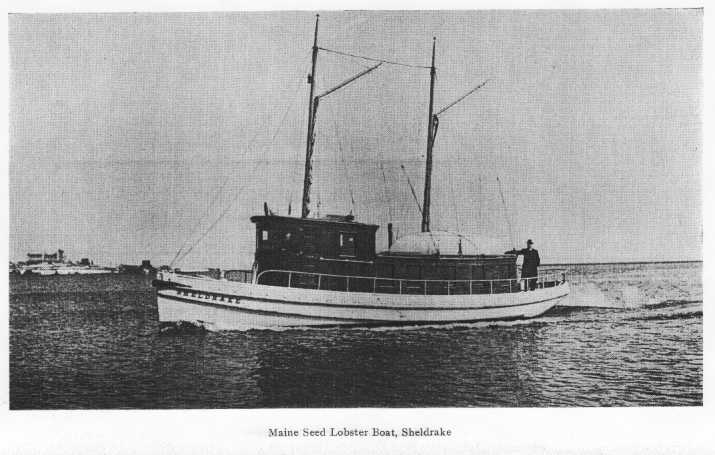
This variety of fish at one time was of great commercial value to the State, but at the present time is comparatively of very little value. One reason for this decrease seems to be that proper care has not been taken to provide suitable fishways, the only means by which this fish can go from salt water into fresh for the purpose of spawning. Another well-defined cause for the gradual failure of the industry is the pollution of our fresh waters through chemicals and water from mills, especially from sawmills, which gradually raises the bed of the stream and especially fills up pools below the dams, where the fish bunch-up before taking the fishways for fresh water. There are apparently no other reasons for the almost practical failure of this industry. In a great measure the fault rests not so much with the law which gives the control of this industry to certain towns bordering on spawning streams a-, with fish committees appointed 1)), the towns who fail to see that proper channels it- the form of fishways are provided and courses for the return of the voting fish to salt water. Private interests in dams and water privileges are too often considered, where beyond a trifling expense, no harm could possibly he done if proper ways and courses are provided.
The catch of bass is of comparatively small commercial importance to the State, and an industry which it does not seem practical at the present time to attempt to develop.
The clam industry is one of great importance from a commercial standpoint, for shipment to other markets, also as food, for the people of the State. In some locations, usually those in the vicinity of clam factories, also near summer hotels and cottages, the supply has been greatly depleted, so much so, that at the present time there are very few clams to be found in flats that were previously very prolific. Actual experiments show that any grounds can be easily replenished by systematic planting. The Department has, within the past few years, planted several beds in different parts of the State, and results show that it is practically as easy and feasible to raise clams from seed as it is to raise potatoes.
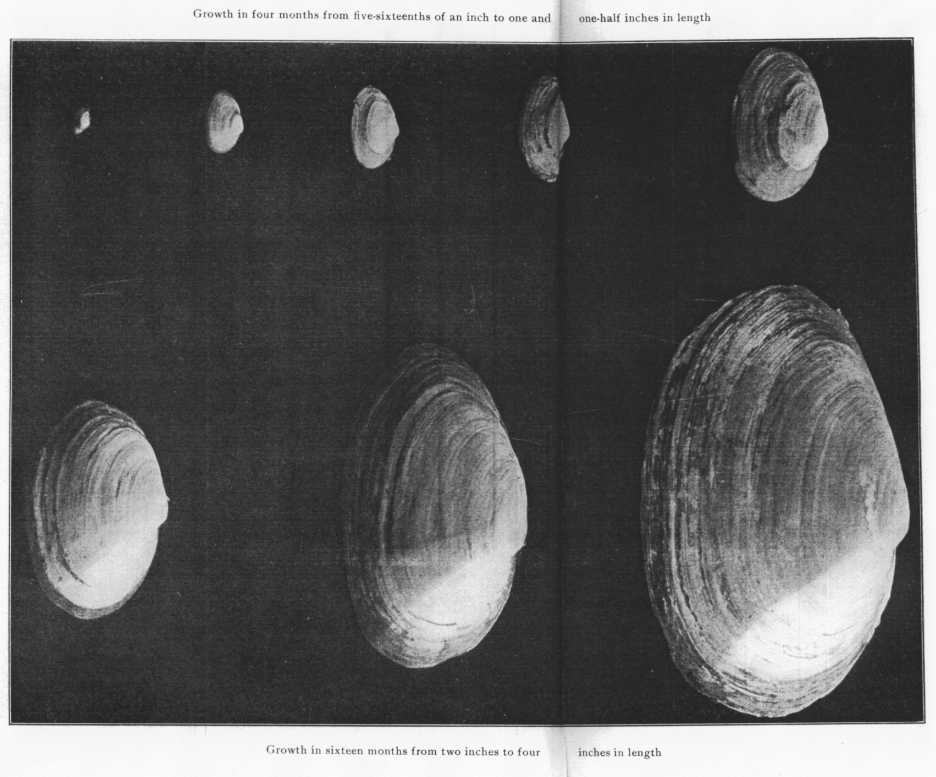
There are many things which must be taken into consideration, the size and condition of the clam, the kind of soil, the time of day, the time of tide, etc. The main point in planting is to get the largest possible proportion of the clams well installed in their burrows. Where the flats are quite hard, a fur-rower, drawn by horses, that will dig three or four furrows about one foot apart at a time, should be used; then have the clams dropped into the furrows; when the tide comes in it will
This is one of the minor varieties and there are a few caught in nearly all the rivers along the coast, usually by the inhabitants located nearby, who do not make a business of fishing, but catch them with spears from boats and also with spears through the ice in the winter months. Lincoln County is the largest producing county for this variety.
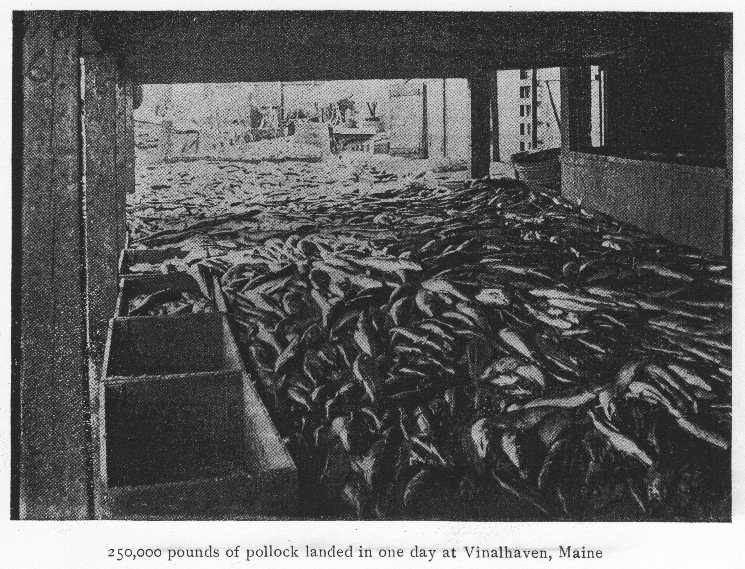
Cod, Haddock, Hake, Pollock and Cusk are the principal varieties that come under this head. There are a very large number of people employed in this fishery; it is one of the largest in the Department. It has not been necessary for the State to pass any general protective laws in reference to deep sea fishing. The catch varies from year to year, caused principally by conditions of the weather, lack of bait, and the ravages of the dog fish, which some years are very much more plentiful than others, but always more plentiful than welcome. The value of the ground fish is gradually increasing, as some of the species that were in years past of very little value, are now classed among the most valuable. The haddock, for instance, which is now considered the best of the ground fish as a fresh fish, at
This is the most prolific variety of fish caught on the coast and directly and indirectly probably of the most money and economic value. The indirect value of the fish comes from the fact that the ground fish industry and the lobster catchers are almost entirely dependent upon herring for bait, and failure of the herring fisheries or inability to procure on account of extreme prices asked, is a serious hardship to this class of fishermen. The direct value of the fish comes from their enormous use when packed as sardines; large herring used for pickling and smoking; small size packed in boxes; also made into boneless, so called, packed in glass jars and cartons; large and medium, put in cold storage for bloaters and for use as bait. On account of this enormous direct and indirect use and from the fact that herring are always caught in schools, there has always been more or less friction between the weirmen and seiners as to their respective rights. The law as now on our statute books is not at all satisfactory, either to this Department or to either class of catchers.
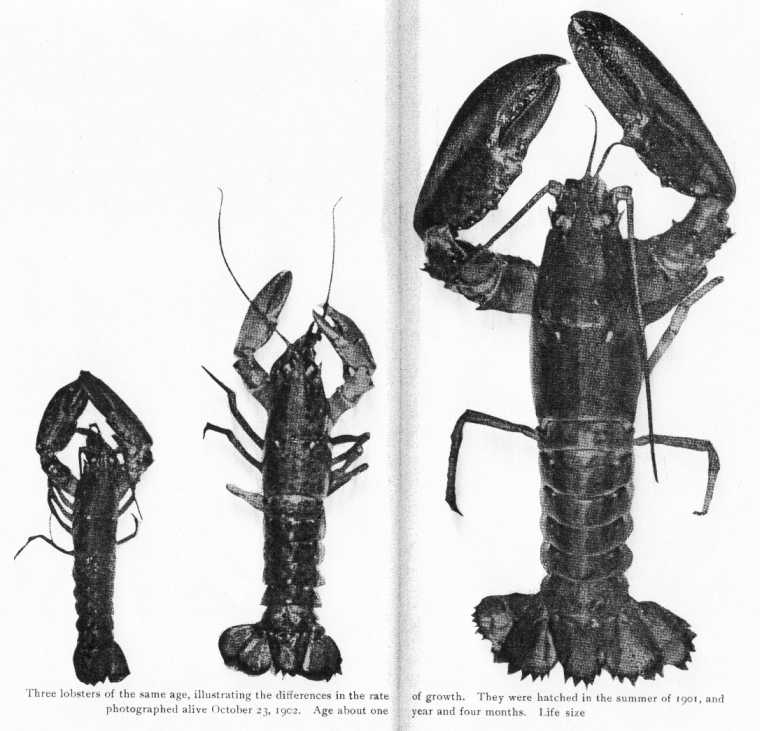
The lobster business for the past two years has been very satisfactory, not only to the Department, but also to all persons engaged therein. There has always been a difference of opinion as to the best methods to adopt for the protection of lobsters, but from results of experiments that have been made, the lobster fishermen generally believe that the present methods are right, and they are co-operating with the Department. The method of handling breeding lobsters as adopted by this State is now almost universally acknowledged to be the best, and for the benefit of those who are not familiar with the system, I will make an explanation.
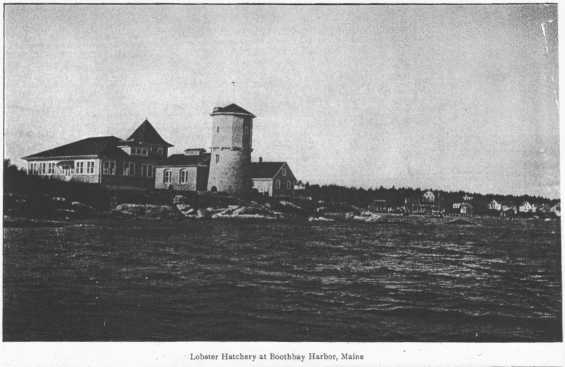
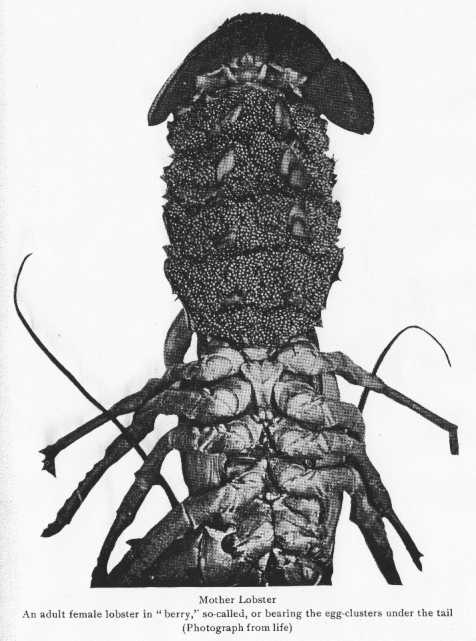
This species is one of the choicest of the salt water fish, and at one time was plentiful along the New England coast, but for the past twenty years the catch has been growing less year by year.
The reason for this decrease is more or less problematic, and it is generally conceded that the method of catching with seines has had a very bad effect. Before the seines came into general use, the mackerel were caught principally with hook and line, although some were caught in mesh nets. The method of fishing with hook and line was to throw what was called toll bait, made of porgies, herring, clam, and such fish mixed together and chopped fine. This was strewn on the water from the vessel's deck and attracted the mackerel in schools around the vessel, where they were caught by baited hook and line. Naturally with a system of this kind, there would be large amounts of this toll bait settle to the bottom, and as it was usually thrown in bays where mackerel frequently schooled, it would have a tendency to attract and hold the mackerel in those locations, and also made excellent food for the fish. The habits of the mackerel during the winter months is a mystery up to the present time. We know, however, that the first mackerel are seen in the spring, usually in large schools bound for the spawning beds. They are met off. Hatteras by a fleet of seiners and drag netters, and if the weather is suitable, large catches are often made; examination of these fish when put upon the market shows that the), are loaded with spawn ; they are caught and destroyed before they have an opportunity to deposit the spawn,
This is a shell fish to which until within a few years very little attention has been paid, but, recently this Department has given oyster culture a very thorough investigation and also made several experiments, with the result that it is now demonstrated beyond a doubt, that oysters can be successfully propagated in Maine. The method of planting oysters is simple, but there are a few special conditions necessary in order to get good results, viz. : It is necessary to have a fairly clean bottom, free from eel grass, kelp, muscles, star fish and other things that foul the bottom. In this State, on account of, the temperature of the water in the winter time, they should not be planted where there is less than five feet of water at low tide. The most rapid growth is obtained when the beds are in a location where there is brackish water, caused by the fresh and salt water coming together by the ebb and flood of the tide. It is also necessary to have a location where there is a tide current as the oyster feeds on substances carried in the water and must have the food brought to them, as they cannot get to it themselves.
The scallop fishery is comparatively new in this State, being largely developed since the advent of the motor boat, although scallops have been caught in small quantities in the State for a number of years. Penobscot Bay has the largest and most prolific beds yet discovered, and very large quantities of scallops are taken from them each year. The scallop is better as a food during cold weather, and the demand is much greater during the cool months of the year. It is not unusual on any good day in winter, to see from sixty to one hundred scallop boats dragging in Penobscot Bay.
These fish were once very plentiful in the rivers of this State, especially in the Kennebec, but in recent years the catch has been gradually decreasing so that it has now become very small, although the catch on the Kennebec and vicinity this year has been larger than formerly. Two years ago large schools of very large
The smelt is one of our smallest, also one of the best food fish, and while its commercial value is not so large as some of the other varieties, it amounts to practically one hundred thousand dollars per year. It furnishes employment for a number of men. in the winter time when other employment cannot be obtained. The laws regulating this industry come mostly under the head of special laws, which have been passed at the request of residents .of particular localities where the fish are most abundant. L assume that residents of these localities where special laws apply, are satisfied, and therefore have no recommendation to make, than to repeat what I have said in connection with some of the other industries, namely, that the laws are not at all uniform as to different localities \\-here apparently almost identical conditions exist.
For some years past, especially since motor boats have come into such common use both for business and pleasure, there has been a good deal of general complaint as well as some made to, this Department officially in reference to the abandonment of weirs.
The summary tables in this report are believed to contain in a condensed form all valuable data pertaining to the fisheries. From these tables it is possible for any one interested to .make up other tables giving special data as to particular localities or industries. The entire report has been condensed as much as possible consistent with clearness.
J. F. Goldthwaite. Biddeford
George A. Dow. Portland
I. H. Snow. Brunswick
J. R. Wallace. Long Island
A. C. Johnson Ashdale
C. A. Fossett. Boothbay Harbor
N. J. Hanna. New Harbor
R. T. York. Damariscotta Mills
C. S. Coughlin. Rockland
A. J. Rawley. Tenant's Harbor
T. E. Sullivan. Bangor
Leander R. Bunker. Cranberry Isles
James A. Hill. West Gouldsboro
F. L. Hodgkins. Lamoine
W. B. Thurlow. Stonington
W. W. Blood. Milbridge
James A. Foster. East Machias
D. O. French. Jonesport
W. A. Henderson. Cutler
J. L. Parker. Eastport
F. A. Townsend. Calais
Joseph W. Lord . Portland October 18, 1906
Charles A. Dyer. Portland November 11, 1906
C. A. Studley. Portland December 12, 1906
A. E. Nickerson. Boothbay Harbor December 11, 1908
George H. Lyons. Eastport January 1, 1906
Joseph Farris. Eastport March 16, 1906
Loring E. Holmes. Robbinston August 6, 1907
J. R. Holmes. Eastport December 11, 1908
Leander R. Bunker (not qualified). Cranberry Isle August 17, 1909
William Teel. Long Island November 11, 1909
Clarence E. McIntire. Long Island April 22, 1910
